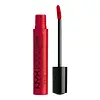What's inside
What's inside
 Key Ingredients
Key Ingredients

 Benefits
Benefits

 Concerns
Concerns

 Ingredients Side-by-side
Ingredients Side-by-side

Ricinus Communis Seed Oil
MaskingIsostearyl Isostearate
EmollientCaprylic/Capric Triglyceride
MaskingDimer Dilinoleyl Dimer Dilinoleate
EmollientTribehenin
EmollientC10-18 Triglycerides
EmollientPolyethylene
AbrasiveBis-Diglyceryl Polyacyladipate-2
EmollientHelianthus Annuus Seed Cera
EmollientHelianthus Annuus Seed Wax
Skin ConditioningCopernicia Cerifera Wax
Carica Papaya Fruit Extract
Skin ConditioningHelianthus Annuus Seed Oil
EmollientAscorbyl Palmitate
AntioxidantTocopherol
AntioxidantBeta-Sitosterol
Emulsion StabilisingSqualene
EmollientPhenoxyethanol
PreservativeTropolone
Skin ConditioningAroma
CI 77891
Cosmetic ColorantCI 77491
Cosmetic ColorantCI 77492
Cosmetic ColorantCI 77499
Cosmetic ColorantCI 77742
Cosmetic ColorantCI 42090
Cosmetic ColorantCI 19140
Cosmetic ColorantCI 15850
Cosmetic ColorantRicinus Communis Seed Oil, Isostearyl Isostearate, Caprylic/Capric Triglyceride, Dimer Dilinoleyl Dimer Dilinoleate, Tribehenin, C10-18 Triglycerides, Polyethylene, Bis-Diglyceryl Polyacyladipate-2, Helianthus Annuus Seed Cera, Helianthus Annuus Seed Wax, Copernicia Cerifera Wax, Carica Papaya Fruit Extract, Helianthus Annuus Seed Oil, Ascorbyl Palmitate, Tocopherol, Beta-Sitosterol, Squalene, Phenoxyethanol, Tropolone, Aroma, CI 77891, CI 77491, CI 77492, CI 77499, CI 77742, CI 42090, CI 19140, CI 15850
Isododecane
EmollientPetrolatum
EmollientTrimethylsiloxysilicate
EmollientCyclopentasiloxane
EmollientPolybutene
Dimethicone
EmollientCopernicia Cerifera Wax
Cyclohexasiloxane
EmollientKaolin
AbrasiveSilica Dimethyl Silylate
EmollientGlyceryl Behenate/Eicosadioate
EmollientPersea Gratissima Oil
Skin ConditioningOlea Europaea Fruit Oil
MaskingPhytosterols
Skin ConditioningTocopherol
AntioxidantGlycerin
HumectantAlumina
AbrasiveCaprylyl Glycol
EmollientPhenoxyethanol
PreservativeMica
Cosmetic ColorantCI 77891
Cosmetic ColorantIron Oxides
CI 42090
Cosmetic ColorantCI 77742
Cosmetic ColorantCI 15850
Cosmetic ColorantCI 45410
Cosmetic ColorantCI 73360
Cosmetic ColorantCI 19140
Cosmetic ColorantCI 77120
Cosmetic ColorantRosin
Isododecane, Petrolatum, Trimethylsiloxysilicate, Cyclopentasiloxane, Polybutene, Dimethicone, Copernicia Cerifera Wax, Cyclohexasiloxane, Kaolin, Silica Dimethyl Silylate, Glyceryl Behenate/Eicosadioate, Persea Gratissima Oil, Olea Europaea Fruit Oil, Phytosterols, Tocopherol, Glycerin, Alumina, Caprylyl Glycol, Phenoxyethanol, Mica, CI 77891, Iron Oxides, CI 42090, CI 77742, CI 15850, CI 45410, CI 73360, CI 19140, CI 77120, Rosin
 Reviews
Reviews

Ingredients Explained
These ingredients are found in both products.
Ingredients higher up in an ingredient list are typically present in a larger amount.
Ci 15850 is the pigment color red. It is an azo dye and created synthetically.
Azo dyes need to be thoroughly purified before use. This allows them to be more stable and longer-lasting.
This ingredient is common in foundations, lipsticks, and blushes. This color is described as brown/orangey red.
It has many secondary names such as Red 6 and Red 7. According to a manufacturer, Red 6 usually contains aluminum.
Learn more about CI 15850CI 19140 is also known as Tartrazine. Tartrazine is a synthetic dye used in cosmetics, foods, and medicine to add a yellow color.
Tartrazine is created from petroleum and is water-soluble.
Some people may experience allergies from this dye, especially asthmatics and those with an aspirin intolerance.
Learn more about CI 19140Ci 42090 is a synthetic dye created from petroleum. It is used to give a bright blue color to cosmetics, medicine, and food.
This ingredient is used to add a violet color to cosmetics.
It is created by reacting phosphoric acid, ammonium dihydrogen orthophosphate, and manganese dioxide.
Ci 77891 is a white pigment from Titanium dioxide. It is naturally found in minerals such as rutile and ilmenite.
It's main function is to add a white color to cosmetics. It can also be mixed with other colors to create different shades.
Ci 77891 is commonly found in sunscreens due to its ability to block UV rays.
Learn more about CI 77891Copernicia Cerifera Wax comes from a palm tree native to Brazil; another name for this ingredient is Carnauba Wax.
This ingredient is used to thicken texture and also leaves behind a film when applied.
Fun fact: This wax has the highest melting point of all natural waxes and low solubility.
Learn more about Copernicia Cerifera WaxPhenoxyethanol is a preservative that has germicide, antimicrobial, and aromatic properties. Studies show that phenoxyethanol can prevent microbial growth. By itself, it has a scent that is similar to that of a rose.
It's often used in formulations along with Caprylyl Glycol to preserve the shelf life of products.
Tocopherol (also known as Vitamin E) is a common antioxidant used to help protect the skin from free-radicals and strengthen the skin barrier. It's also fat soluble - this means our skin is great at absorbing it.
Vitamin E also helps keep your natural skin lipids healthy. Your lipid skin barrier naturally consists of lipids, ceramides, and fatty acids. Vitamin E offers extra protection for your skin’s lipid barrier, keeping your skin healthy and nourished.
Another benefit is a bit of UV protection. Vitamin E helps reduce the damage caused by UVB rays. (It should not replace your sunscreen). Combining it with Vitamin C can decrease sunburned cells and hyperpigmentation after UV exposure.
You might have noticed Vitamin E + C often paired together. This is because it is great at stabilizing Vitamin C. Using the two together helps increase the effectiveness of both ingredients.
There are often claims that Vitamin E can reduce/prevent scarring, but these claims haven't been confirmed by scientific research.
Learn more about Tocopherol